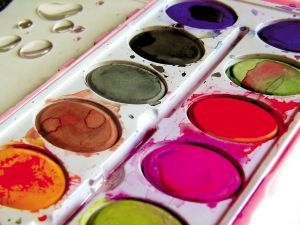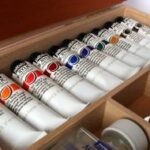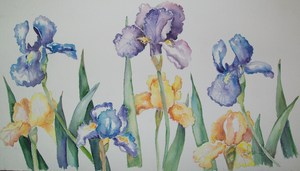The best way to be good at something is to start with the basics. With art, this is especially important. Watercolor is one of the easiest medias to manipulate, and it can also be one of the most beautiful medias if done right. Although there are some people who do not need any practice and are automatically great at watercolor painting, this is the majority. The best way to get better at watercolors is to master the basic techniques.
Flat wash
A fla twash is an even toned wash of the same color. This is usually used to lay down a background for your painting. To practice creating a perfect flat wash, get a blank piece of paper, a square paintbrush, and paint, and water. Picking a darker color is best because they are seen easier, colors like yellow are bad because they can be hard to see in certain lights. Draw a square on your piece of paper. Now dip your paintbrush into the paint, make sure that you soak the paintbrush with paint, but not to the point where the paint is dripping. Now start at one end of the square, and make a straight stroke to the other end. Do this until you get to the bottom of your square, and try to maintain an even tone throughout the square. Once you have finished, let your flat wash dry and check to see if the paint looks even when dried, if it does, you have succeeded, if not, more practice is needed.
Graded Wash
A graded wash is a wash that starts out dark and gradually gets lighter. To practice your graded washes, draw a square on a blank piece of paper. As with the flat wash, it is best to pick darker colors, because light colors may be difficult to see. Dip your paintbrush into the paint, and make sure that the paintbrush absorbs a great deal of the paint. Now start at one end of the square and make a clean stroke to the other side of the square. Mix your paint with a little bit more water, to make the color appear lighter. Dip your paintbrush in that mixture, and make a clean stroke across the square directly beneath your first stroke. Continue this process until you get to the end of the square. Make sure that there are no major color breaks between your strokes. Let the wash dry, and if it looks as if the color is gradually getting lighter, with only subtle changes, you have succeeded, if not, more practice is needed.
Glazing
Glazing is very similar to the washes. Instead of the entire area your are painting being covered, glazes are only done is certain areas of your canvas. Glazing is done over washes, which have to be dry before the glaze can be applied. Glazes are used to even out and make minor adjustments to the washes that were previously applied. You will need to use a smaller paintbrush for glazes, and since this is not used for a background, practicing on a square won’t do you any good. Practice your glazes on shapes. The paint needs to be mixed with a great deal of water so that it is almost transparent when applied. Glazing is great for creating shadows and different values.
Wet in Wet
The wet in wet technique is when the artist applies the wet paint to a paper or canvas that is already wet. You can wet your canvas with a spray bottle, a sponge, or even a wet paintbrush (with no paint on it). Once the canvas is wet, apply the paint. Because the canvas is already wet, this will create a much different effect with the paint. This effect is great for creating background images, such as the sky, or grass. It is also great for landscapes that involve lots of trees, and things similar. The best way to practice the wet in wet technique is to simply create paintings using the technique.
Drybrush
Drybrush is usually used for small details. In order for this technique to work properly, the paper or canvas has to be completely dry. This technique is usually done when the painting is almost done to add the finishing touches. Dry brush means that the paint is only mixed with a little water. Using this technique will allow you to add lots of details that you would not be able to do with a regular wet brush. This technique is not very difficult, but if you want to practice the best way is to get a blank piece of paper and practice your lines.




